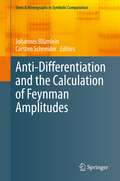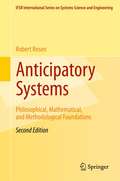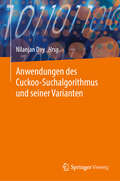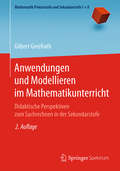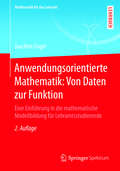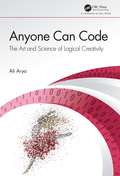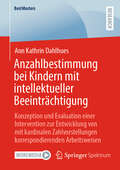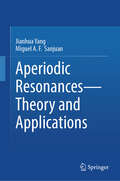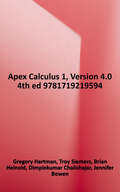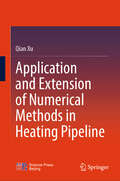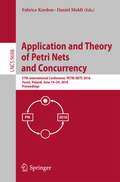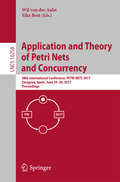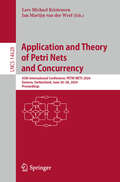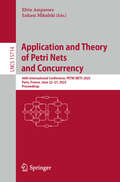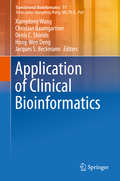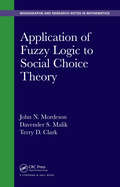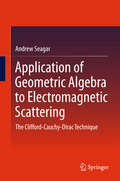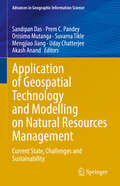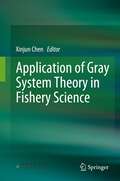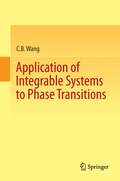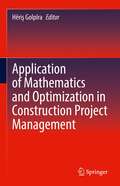- Table View
- List View
Anti-Differentiation and the Calculation of Feynman Amplitudes (Texts & Monographs in Symbolic Computation)
by Carsten Schneider Johannes BlümleinThis volume comprises review papers presented at the Conference on Antidifferentiation and the Calculation of Feynman Amplitudes, held in Zeuthen, Germany, in October 2020, and a few additional invited reviews. The book aims at comprehensive surveys and new innovative results of the analytic integration methods of Feynman integrals in quantum field theory. These methods are closely related to the field of special functions and their function spaces, the theory of differential equations and summation theory. Almost all of these algorithms have a strong basis in computer algebra. The solution of the corresponding problems are connected to the analytic management of large data in the range of Giga- to Terabytes. The methods are widely applicable to quite a series of other branches of mathematics and theoretical physics.
Anticipatory Systems: Philosophical, Mathematical, and Methodological Foundations (IFSR International Series in Systems Science and Systems Engineering #1)
by Robert RosenRobert Rosen was not only a biologist, he was also a brilliant mathematician whose extraordinary contributions to theoretical biology were tremendous. Founding, with this book, the area of Anticipatory Systems Theory is a remarkable outcome of his work in theoretical biology. This second edition of his book Anticipatory Systems, has been carefully revised and edited, and includes an Introduction by Judith Rosen. It has also been expanded with a set of Prolegomena by Dr. Mihai Nadin, who offers an historical survey of this fast growing field since the original work was published. There is also some exciting new work, in the form of an additional chapter on the Ontology of Anticipation, by Dr. John Kineman. An addendum-- with autobiographical reminiscences by Robert Rosen, himself, and a short story by Judith Rosen about her father-- adds a personal touch. This work, now available again, serves as the guiding foundations for the growing field of Anticipatory Systems and, indeed, any area of science that deals with living organisms in some way, including the study of Life and Mind. It will also be of interest to graduate students and researchers in the field of Systems Science.
Ants Rule: The Long and Short of It
by Bob BarnerMite-size engineers construct the perfect roller coaster in this fun-filled introduction to measurement and data presentation.The ants need to plan the Blowout Bug Jamboree! But how can they build a roller coaster for the festival if they don't know how many bugs will come, or how big those bugs will be? This enjoyable introduction to measurement, comparison, and data visualization focuses on building math skills that aren't dependent on units-- so it works equally well for young readers used to inches or centimeters. And most of all-- it's fun! Colorful cut-paper art brings the bugs-- and their creations-- to life. In a deluxe fold-out spread, everything comes together in a huge, perfect rollercoaster-- big enough for all the bugs at the Jamboree to enjoy, and filled with tiny details for clever readers to spot!
Anwendungen des Cuckoo-Suchalgorithmus und seiner Varianten
by Nilanjan DeyDieses Buch betont die grundlegenden Konzepte des CS-Algorithmus und seiner Varianten sowie deren Anwendung zur Lösung unterschiedlicher Optimierungsprobleme in medizinischen und ingenieurwissenschaftlichen Anwendungen. Evolutionäre metaheuristische Ansätze werden zunehmend zur Lösung komplexer Optimierungsprobleme in verschiedenen realen Anwendungen eingesetzt. Einer der erfolgreichsten Optimierungsalgorithmen ist die Cuckoo-Suche (CS), die zu einem aktiven Forschungsbereich geworden ist, um N-dimensionale und lineare/nichtlineare Optimierungsprobleme mithilfe einfacher mathematischer Prozesse zu lösen. CS hat die Aufmerksamkeit verschiedener Forscher auf sich gezogen, was zur Entstehung zahlreicher Varianten des grundlegenden CS mit verbesserten Leistungsmerkmalen seit 2019 geführt hat.
Anwendungen und Modellieren im Mathematikunterricht: Didaktische Perspektiven zum Sachrechnen in der Sekundarstufe (Mathematik Primarstufe und Sekundarstufe I + II)
by Gilbert GreefrathDie in diesem Buch dargestellten Anwendungen prägen den aktuellen Mathematikunterricht der Sekundarstufe. Didaktische Perspektiven zum Sachrechnen und das mathematische Modellieren sind eine wichtige Grundlage für die Lehrerbildung. Auch die aktuellen Bildungsstandards stellen prozessbezogene Kompetenzen wie das Modellieren in den Vordergrund. In diesem Lehrbuch lernen Sie aktuelle Sichtweisen auf Anwendungen im Mathematikunterricht vor dem Hintergrund des Sachrechnens und des mathematischen Modellierens kennen. Besonders ausführlich werden die vielfältigen Aufgabentypen eines anwendungsorientierten Mathematikunterrichts dargestellt und klassifiziert. Hier erhalten Sie auch viele Anregungen für den Unterricht. Einige typische Unterrichtsinhalte zu Anwendungen in der Sekundarstufe wie Zuordnungen von Größen und der Einsatz digitaler Werkzeuge runden den Band ab. Das Buch wendet sich an Lehramtsstudierende, Referendarinnen und Referendare sowie Lehrkräfte mit Mathematik als Fach.
Anwendungsorientierte Mathematik: Eine Einführung in die mathematische Modellbildung für Lehramtsstudierende (Mathematik für das Lehramt)
by Joachim EngelGegenstand des vorliegenden Lehrbuches ist der Prozess des Anwendens von Mathematik. Im Mittelpunkt stehen dabei der Funktionsbegriff sowie mathematische Methoden zur Modellierung funktionaler Abh#65533;ngigkeiten zwischen zwei Gr#65533;#65533;en. Das Buch zeichnet sich durch folgende besondere Merkmale aus: Reale Daten als Grundlage f#65533;r viele Modellierungen als eine wichtige Voraussetzung f#65533;r einen authentischen und glaubw#65533;rdigen Unterricht an Hochschule und Schule. Einsatz von Technologie als Werkzeug zum Probleml#65533;sen und zur Illustrierung von Konzepten und Zusammenh#65533;ngen. Vernetzung verschiedener Inhalte der Mathematik wie Elementare Funktionenlehre, Analysis, Stochastik, Lineare Algebra,Numerik. Detaillierte Ableitungen von Ergebnissen sowie #65533;bungen und Fragen am Ende der einzelnen Kapitel mit teilweise ausgearbeiteten L#65533;sungen und mit L#65533;sungshinweisen helfen bei der Vertiefung des Stoffes.
Anyone Can Code: The Art and Science of Logical Creativity
by Ali Arya"Ali Arya guides you in a fantastic journey full of creativity in a coherent way that allows the traveler to learn and build up over the knowledge acquired in previous chapters until the reader accomplishes skills to develop solutions using programming." — Andrés A. Navarro Newball, Professor, Pontificia Universidad Javeriana, Cali, Colombia "An excellent book that teaches programming and software development the way it should be done: independent from a specific implementation language and focusing on the main principles that are fundamental and substantive to any kind of software production." — Marc Conrad, Principal Lecturer, University of Bedfordshire, Luton, UK Anyone Can Code: The Art and Science of Logical Creativity introduces computer programming as a way of problem-solving through logical thinking. It uses the notion of modularization as a central lens through which we can make sense of many software concepts. This book takes the reader through fundamental concepts in programming by illustrating them in three different and distinct languages: C/C++, Python, and Javascript. Key features: Focuses on problem-solving and algorithmic thinking instead of programming functions, syntax, and libraries Includes engaging examples, including video games and visual effects Provides exercises and reflective questions This book gives beginner and intermediate learners a strong understanding of what they are doing so that they can do it better and with any other tool or language that they may end up using later. Author Ali Arya is an Associate Professor in the School of Information Technology at Carleton University, Ottawa, Canada. He received his PhD in Computer Engineering from the University of British Columbia, Vancouver, Canada, in 2003. He has over 25 years of experience in professional and academic positions related to software development and information technology. He is passionate about computer programming that brings together logical and creative abilities.
Anzahlbestimmung bei Kindern mit intellektueller Beeinträchtigung: Konzeption und Evaluation einer Intervention zur Entwicklung von mit kardinalen Zahlvorstellungen korrespondierenden Arbeitsweisen (BestMasters)
by Ann Kathrin DahlhuesIm Rahmen des Forschungsprojektes wird der Frage nachgegangen, wie sich die Arbeitsweisen zur Anzahlbestimmung bei Kindern mit intellektueller Beeinträchtigung unter Berücksichtigung der kardinalen Zahlvorstellung während einer Förderung der Menge-Zahl-Zuordnung entwickeln. Dabei liegt der Fokus auf der Bestimmung strukturiert dargestellten Anzahlen innerhalb des Zwanzigerfeldes. Um diese Frage beantworten zu können, wurde eine Einzelfallstudie mit zwei Kindern des dritten Schulbesuchsjahres einer Förderschule mit dem Schwerpunkt geistige Entwicklung durchgeführt (ZR6 und ZR20). Die Studie umfasste eine Prä- und Post-Standortanalyse, Einzelfördereinheiten sowie Verlaufstestungen. Der Fokus der Fördereinheiten lag auf der Mengenwahrnehmung, dem Zählen und der Herstellung von Beziehungen zwischen den Zahlen unter Berücksichtigung des intermodalen Transfers. Es zeigt sich, dass die Kinder strukturiert dargestellte Anzahlen nicht mehr immer zählend beantworten, sondern überwiegend die direkte Anzahlnennung nutzen. Auch die Strukturen des Zwanzigerfeldes können immer mehr erkannt und genutzt werden. Dennoch gibt es sowohl Schwankungen in der Lösungshäufigkeit als auch in der Lösungsgeschwindigkeit.
Aperiodic Order: A Mathematical Invitation
by Michael Baake Uwe GrimmQuasicrystals are non-periodic solids that were discovered in 1982 by Dan Shechtman, Nobel Prize Laureate in Chemistry 2011. The underlying mathematics, known as the theory of aperiodic order, is the subject of this comprehensive multi-volume series. This first volume provides a graduate-level introduction to the many facets of this relatively new area of mathematics. Special attention is given to methods from algebra, discrete geometry and harmonic analysis, while the main focus is on topics motivated by physics and crystallography. In particular, the authors provide a systematic exposition of the mathematical theory of kinematic diffraction. Numerous illustrations and worked-out examples help the reader to bridge the gap between theory and application. The authors also point to more advanced topics to show how the theory interacts with other areas of pure and applied mathematics.
Aperiodic Order: Crystallography and Almost Periodicity (Encyclopedia of Mathematics and its Applications #166)
by Michael Baake Uwe GrimmQuasicrystals are non-periodic solids that were discovered in 1982 by Dan Shechtman, Nobel Prize Laureate in Chemistry 2011. The mathematics that underlies this discovery or that proceeded from it, known as the theory of Aperiodic Order, is the subject of this comprehensive multi-volume series. This second volume begins to develop the theory in more depth. A collection of leading experts, among them Robert V. Moody, cover various aspects of crystallography, generalising appropriately from the classical case to the setting of aperiodically ordered structures. A strong focus is placed upon almost periodicity, a central concept of crystallography that captures the coherent repetition of local motifs or patterns, and its close links to Fourier analysis. The book opens with a foreword by Jeffrey C. Lagarias on the wider mathematical perspective and closes with an epilogue on the emergence of quasicrystals, written by Peter Kramer, one of the founders of the field.
Aperiodic Resonances - Theory and Applications
by Miguel A. Sanjuan Jianhua YangThis book presents various types of aperiodic resonances in the form of a complete theoretical framework for the first time. It makes aperiodic resonance be a new disciplinary direction. In addition to the achievements in existing papers, the book proposes some new methods and discovers some new phenomena about different aperiodic resonances in nonlinear systems. The book includes theoretical analysis methods and their applications in three typical engineering backgrounds. It links theoretical researches on physical phenomena with different engineering problems. It aims to solve engineering problems from a new perspective based on aperiodic resonance theories.
Apex Calculus 1
by Gregory Hartman Troy Siemers Brian Heinold Dimplekumar ChalishajarA Calculus text covering limits, derivatives, and the basics of integration. This book contains numerous examples and illustrations to help make concepts clear. The follow-up to this text is Calculus 2, which reviews the basic concepts of integration, and then covers techniques and applications of integration, followed by sequences and series. Calculus 3 finishes this series by covering parametric equations, polar coordinates, vector valued functions, multivariable functions and vector analysis. A free .pdf version of all three can be obtained at apexcalculus.com.
Appalachian Set Theory 2006-2012
by James Cummings Ernest SchimmerlingThis volume takes its name from a popular series of intensive mathematics workshops hosted at institutions in Appalachia and surrounding areas. At these meetings, internationally prominent set theorists give one-day lectures that focus on important new directions, methods, tools and results so that non-experts can begin to master these and incorporate them into their own research. Each chapter in this volume was written by the workshop leaders in collaboration with select student participants, and together they represent most of the meetings from the period 2006-2012. Topics covered include forcing and large cardinals, descriptive set theory, and applications of set theoretic ideas in group theory and analysis, making this volume essential reading for a wide range of researchers and graduate students.
Application and Extension of Numerical Methods in Heating Pipeline
by Qian XuThis book is a summary of the author's pioneering work on the theory of heating pipelines and its application expansion over the years, trying to establish a complete logical system from the basic theory of pipelines to the application of heating pipelines to the innovation and expansion of large-diameter energy transmission pipelines. These esoteric fundamental theories are linked to practical applications, and numerical simulations are used to help readers understand the problems faced by pipelines in engineering practice. The book consists of four chapters, the first chapter describes the basic concepts of district heating system, related standards, development history, facing problems and future prospects, while for the basic characteristics of district heating pipe network installation and laying methods made an introduction; followed by the second chapter summarizes and organizes the pipeline safety research of fluid-solid heat, elastic-plasticity and other basic theories, as well as heating pipeline thermal insulation system heat loss and the economic evaluation of theory and so on. Based on the basic theory of pipeline, the third and fourth chapters introduce several typical pipeline application cases in detail, and each case includes modelling, solving, and result analysis, which can provide readers with technical references and idea guidelines in the field of pipeline research. The third chapter of the different structures of the heating pipeline from the safety and economic aspects of a detailed numerical study; the fourth chapter in the heating pipeline on the basis of energy transportation pipeline, transportation medium from the original hot water, hot steam to the oil and gas, specifically introduced various types of large-diameter energy transportation pipeline under the action of different loads of the dynamic response characteristics. It has important theoretical significance for enriching and developing the basic theory of pipeline and the expansion of all kinds of pipeline applications, and at the same time, it provides technical guidance for the safe, stable, economic and efficient operation of all kinds of long-distance pipelines, such as heating pipelines and energy transmission and transportation pipelines. It helps readers to systematically and comprehensively understand the basic theories of elasticity and plasticity, fluid-solid-thermal coupling, and economic evaluation of pipelines, and at the same time provides readers with new research ideas and technical means from the perspective of scientific research.
Application and Theory of Petri Nets and Concurrency: 37th International Conference, PETRI NETS 2016, Toruń, Poland, June 19-24, 2016. Proceedings (Lecture Notes in Computer Science #9698)
by Fabrice Kordon Daniel MoldtThis book constitutes the proceedings of the 37th International Conference on Application and Theory of Petri Nets and Concurrency, PETRI NETS 2016, held in Toruń, Poland, in June 2016. Petri Nets 2016 was co-located with the Application of Concurrency to System Design Conference, ACSD 2016.The 16 papers including 3 tool papers with 4 invited talks presented together in this volume were carefully reviewed and selected from 42 submissions. Papers presenting original research on application or theory of Petri nets, as well as contributions addressing topics relevant to the general field of distributed and concurrent systems are presented within this volume.
Application and Theory of Petri Nets and Concurrency: 38th International Conference, PETRI NETS 2017, Zaragoza, Spain, June 25–30, 2017, Proceedings (Lecture Notes in Computer Science #10258)
by Wil Van der Aalst Eike BestThis book constitutes the proceedings of the 38th International Conference on Application and Theory of Petri Nets and Concurrency, PETRI NETS 2017, held in Zaragoza, Spain, in June 2017. Petri Nets 2017 is co-located with the Application of Concurrency to System Design Conference, ACSD 2017. The 16 papers, 9 theory papers, 4 application papers, and 3 tool papers, with 1 short abstract and 3 extended abstracts of invited talks presented together in this volume were carefully reviewed and selected from 33 submissions. The focus of the conference is on following topics: Simulation of Colored Petri Nets, Petri Net Tools. - Model Checking, Liveness and Opacity, Stochastic Petri Nets, Specific Net Classes, and Petri Nets for Pathways.
Application and Theory of Petri Nets and Concurrency: 45th International Conference, PETRI NETS 2024, Geneva, Switzerland, June 26–28, 2024, Proceedings (Lecture Notes in Computer Science #14628)
by Jan Martijn van der Werf Lars Michael KristensenThis book constitutes the proceedings of the 45th International Conference on Application and Theory of Petri Nets and Concurrency, PETRI NETS 2024, held in Geneva, Switzerland, during June 26-28, 2024. The 19 full papers and 2 invited papers included in this book were carefully reviewed and selected from 42 submissions. They were organized in topical sections as follows: Business Process Modelling and Mining, Semantics and Complexity, Reachability, Verification and Model Checking, Applications and Tools.
Application and Theory of Petri Nets and Concurrency: 46th International Conference, PETRI NETS 2025, Paris, France, June 22–27, 2025, Proceedings (Lecture Notes in Computer Science #15714)
by Łukasz Mikulski Elvio AmparoreThis book constitutes the proceedings of the 46th International Conference on Application and Theory of Petri Nets and Concurrency, PETRI NETS 2025, held in Paris, France, during June 22–27, 2025. The 21 full papers and 1 short paper included in this book were carefully reviewed and selected from 48 submissions. They deal with topics such as composition and synthesis; workflow nets; process mining; model checking; communication & concurrency; timed and stochastic Petri nets; etc. The proceedings also include one invited talk in full paper length.
Application of Clinical Bioinformatics (Translational Bioinformatics #11)
by Xiangdong Wang Christian Baumgartner Denis C. Shields Hong-Wen Deng Jacques S. BeckmannThis bookelucidates how genetic, biological and medical information can be applied tothe development of personalized healthcare, medication and therapies. Focusingon aspects of the development of evidence-based approaches in bioinformaticsand computational medicine, including data integration, methodologies, toolsand models for clinical and translational medicine, it offers an essentialintroduction to clinical bioinformatics for clinical researchers andphysicians, medical students and teachers, and scientists working with human disease-based omics and bioinformatics. Dr. XiangdongWang is a distinguished Professor of Medicine. He is Director of ShanghaiInstitute of Clinical Bioinformatics, Director of Fudan University Center forClinical Bioinformatics, Deputy Director of Shanghai Respiratory ResearchInstitute, Director of Biomedical Research Center, Fudan University ZhongshanHospital, Shanghai, China; Dr. Christian Baumgartner is a Professor of HealthCare and Biomedical Engineering at Institute of Health Care Engineering withEuropean Notified Body of Medical Devices, Graz University of Technology, Graz,Austria; Dr. Denis Shields is a Professor of ClinicalBioinformatics at Conway Institute, Belfield, Dublin, Ireland; Dr. Hong-Wen Dengis a Professor at Department of Biostatistics and Bioinformatics, Tulane UniversitySchool of Public Health and Tropical Medicine, USA; Dr. Jacques SBeckmann is a Professor and Director of Section of Clinical Bioinformatics,Swiss Institute of Bioinformatics, Switzerland.
Application of Fuzzy Logic to Social Choice Theory
by John N. Mordeson Davender S. Malik Terry D. ClarkFuzzy social choice theory is useful for modeling the uncertainty and imprecision prevalent in social life yet it has been scarcely applied and studied in the social sciences. Filling this gap, Application of Fuzzy Logic to Social Choice Theory provides a comprehensive study of fuzzy social choice theory.The book explains the concept of a fuzzy max
Application of Geometric Algebra to Electromagnetic Scattering: The Clifford-Cauchy-Dirac Technique
by Andrew SeagarThis work presents the Clifford-Cauchy-Dirac (CCD) technique for solving problems involving the scattering of electromagnetic radiation from materials of all kinds. It allows anyone who is interested to master techniques that lead to simpler and more efficient solutions to problems of electromagnetic scattering than are currently in use. The technique is formulated in terms of the Cauchy kernel, single integrals, Clifford algebra and a whole-field approach. This is in contrast to many conventional techniques that are formulated in terms of Green's functions, double integrals, vector calculus and the combined field integral equation (CFIE). Whereas these conventional techniques lead to an implementation using the method of moments (MoM), the CCD technique is implemented as alternating projections onto convex sets in a Banach space. The ultimate outcome is an integral formulation that lends itself to a more direct and efficient solution than conventionally is the case, and applies without exception to all types of materials. On any particular machine, it results in either a faster solution for a given problem or the ability to solve problems of greater complexity. The Clifford-Cauchy-Dirac technique offers very real and significant advantages in uniformity, complexity, speed, storage, stability, consistency and accuracy.
Application of Geospatial Technology and Modelling on Natural Resources Management: Current State, Challenges and Sustainability (Advances in Geographic Information Science)
by Prem C. Pandey Uday Chatterjee Sandipan Das Onisimo Mutanga Suvarna Tikle Mengjiao Jiang Akash AnandThis contributed volume provides coverage of geospatial technology and modelling techniques that are useful for natural resource assessment at various scales, from regional to global. This makes it a valuable resource for researchers, practitioners, scientists, faculties and students interested in understanding how geospatial tools can be used to assess natural resources. The book provides numerous examples of how geospatial technology and modeling can be applied to different natural resource management scenarios, including forest management, wildlife conservation, water resources management, and climate change adaptation. The book takes an interdisciplinary approach to natural resource management, bringing together perspectives from ecology, environment, geography, geology, and other fields.
Application of Gray System Theory in Fishery Science
by Xinjun ChenThis book reviews the gray system and combines its latest research results in fishery science. The chapters cover the basic concept and theory of gray system, original data processing and gray sequence generation, gray correlation analysis, gray cluster analysis, gray system modeling, gray prediction, gray decision-making, and gray linear programming. The theory of gray system is a new cross-sectional discipline founded in 1982 by Professor Deng Julong, a well-known scholar in China. In recent decades, it has not only been deepened and expanded in theory but also widely used in the fields of society, economy, ocean, agriculture, fishery, and other fields, and made a series of significant scientific achievements. These have laid the foundation for the important position of the gray system theory. Due to the great uncertainty of the fishery resources and the fishery environment involved in the fishery science system, which is completely different from the natural resources on the land, the data and information belong to the category of “poor information”, and the variability and uncertainty are greater than other natural resources. As an extremely effective analytical method and tool, gray system theory has been applied increasingly in fishery science. The book is developed based on well-read and practical literature and will help scientists and research units engaged in scientific research and teaching in fishery science and related fields to develop new research methods and tools.
Application of Integrable Systems to Phase Transitions
by C. B. WangThe eigenvalue densities in various matrix models in quantum chromodynamics (QCD) are ultimately unified in this book by a unified model derived from the integrable systems. Many new density models and free energy functions are consequently solved and presented. The phase transition models including critical phenomena with fractional power-law for the discontinuities of the free energies in the matrix models are systematically classified by means of a clear and rigorous mathematical demonstration. The methods here will stimulate new research directions such as the important Seiberg-Witten differential in Seiberg-Witten theory for solving the mass gap problem in quantum Yang-Mills theory. The formulations and results will benefit researchers and students in the fields of phase transitions, integrable systems, matrix models and Seiberg-Witten theory.
Application of Mathematics and Optimization in Construction Project Management
by Hêriş GolpîraThis book provides a broad overview of project and project management principles, processes, and success/failure factors. It also provides a state of the art of applications of the project management concepts, especially in the field of construction projects, based on the Project Management Body of Knowledge (PMBOK). The slate of geographically and professionally diverse authors illustrates project management as a multidisciplinary undertaking that integrates renewable and non-renewable resources in a systematic process to achieve project goals. The book describes assessment based on technical and operational goals and meeting schedules and budgets.
